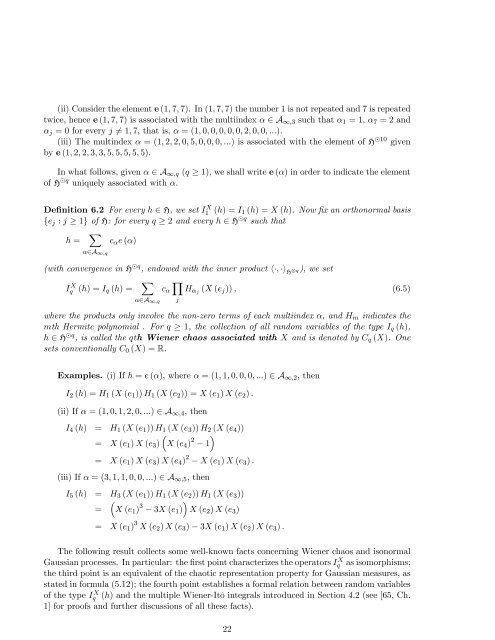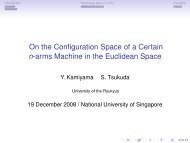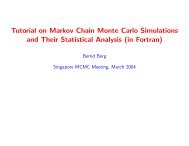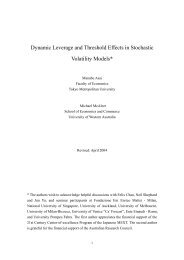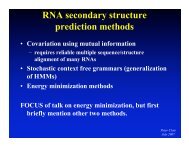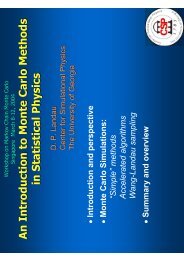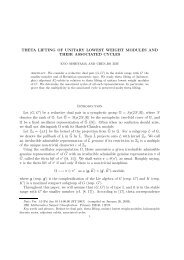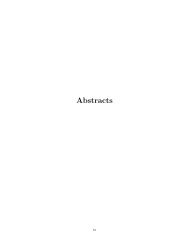Stein's method, Malliavin calculus and infinite-dimensional Gaussian
Stein's method, Malliavin calculus and infinite-dimensional Gaussian
Stein's method, Malliavin calculus and infinite-dimensional Gaussian
You also want an ePaper? Increase the reach of your titles
YUMPU automatically turns print PDFs into web optimized ePapers that Google loves.
(ii) Consider the element e (1; 7; 7). In (1; 7; 7) the number 1 is not repeated <strong>and</strong> 7 is repeated<br />
twice, hence e (1; 7; 7) is associated with the multiindex 2 A 1;3 such that 1 = 1, 7 = 2 <strong>and</strong><br />
j = 0 for every j 6= 1; 7, that is, = (1; 0; 0; 0; 0; 0; 2; 0; 0; :::).<br />
(iii) The multindex = (1; 2; 2; 0; 5; 0; 0; 0; :::) is associated with the element of H 10 given<br />
by e (1; 2; 2; 3; 3; 5; 5; 5; 5; 5).<br />
In what follows, given 2 A 1;q (q 1), we shall write e () in order to indicate the element<br />
of H q uniquely associated with .<br />
De…nition 6.2 For every h 2 H, we set I1<br />
X (h) = I 1 (h) = X (h). Now …x an orthonormal basis<br />
fe j : j 1g of H: for every q 2 <strong>and</strong> every h 2 H q such that<br />
h =<br />
X<br />
c e ()<br />
2A 1;q<br />
(with convergence in H q , endowed with the inner product h; i H q), we set<br />
Iq X (h) = I q (h) = X Y<br />
c H j (X (e j )) , (6.5)<br />
2A 1;q j<br />
where the products only involve the non-zero terms of each multiindex , <strong>and</strong> H m indicates the<br />
mth Hermite polynomial . For q 1, the collection of all r<strong>and</strong>om variables of the type I q (h),<br />
h 2 H q , is called the qth Wiener chaos associated with X <strong>and</strong> is denoted by C q (X). One<br />
sets conventionally C 0 (X) = R.<br />
Examples. (i) If h = e (), where = (1; 1; 0; 0; 0; :::) 2 A 1;2 , then<br />
I 2 (h) = H 1 (X (e 1 )) H 1 (X (e 2 )) = X (e 1 ) X (e 2 ) .<br />
(ii) If = (1; 0; 1; 2; 0; :::) 2 A 1;4 , then<br />
I 4 (h) = H 1 (X (e 1 )) H 1 (X (e 3 )) H 2 (X (e 4 ))<br />
<br />
= X (e 1 ) X (e 3 ) X (e 4 ) 2 1<br />
= X (e 1 ) X (e 3 ) X (e 4 ) 2 X (e 1 ) X (e 3 ) .<br />
(iii) If = (3; 1; 1; 0; 0; :::) 2 A 1;5 , then<br />
I 5 (h) = H 3 (X (e 1 )) H 1 (X (e 2 )) H 1 (X (e 3 ))<br />
<br />
<br />
= X (e 1 ) 3 3X (e 1 ) X (e 2 ) X (e 3 )<br />
= X (e 1 ) 3 X (e 2 ) X (e 3 ) 3X (e 1 ) X (e 2 ) X (e 3 ) .<br />
The following result collects some well-known facts concerning Wiener chaos <strong>and</strong> isonormal<br />
<strong>Gaussian</strong> processes. In particular: the …rst point characterizes the operators Iq<br />
X as isomorphisms;<br />
the third point is an equivalent of the chaotic representation property for <strong>Gaussian</strong> measures, as<br />
stated in formula (5.12); the fourth point establishes a formal relation between r<strong>and</strong>om variables<br />
of the type Iq<br />
X (h) <strong>and</strong> the multiple Wiener-Itô integrals introduced in Section 4.2 (see [65, Ch.<br />
1] for proofs <strong>and</strong> further discussions of all these facts).<br />
22


